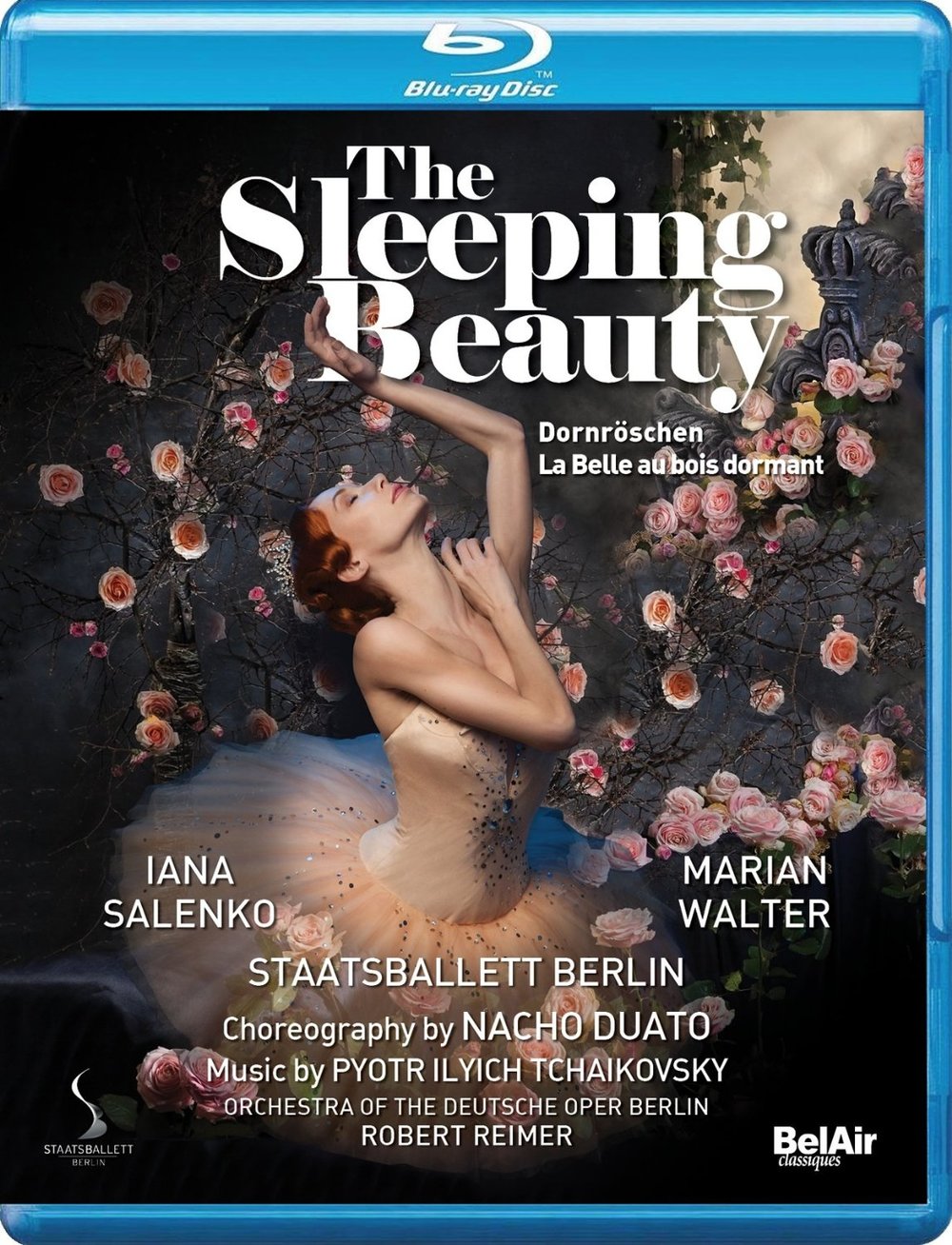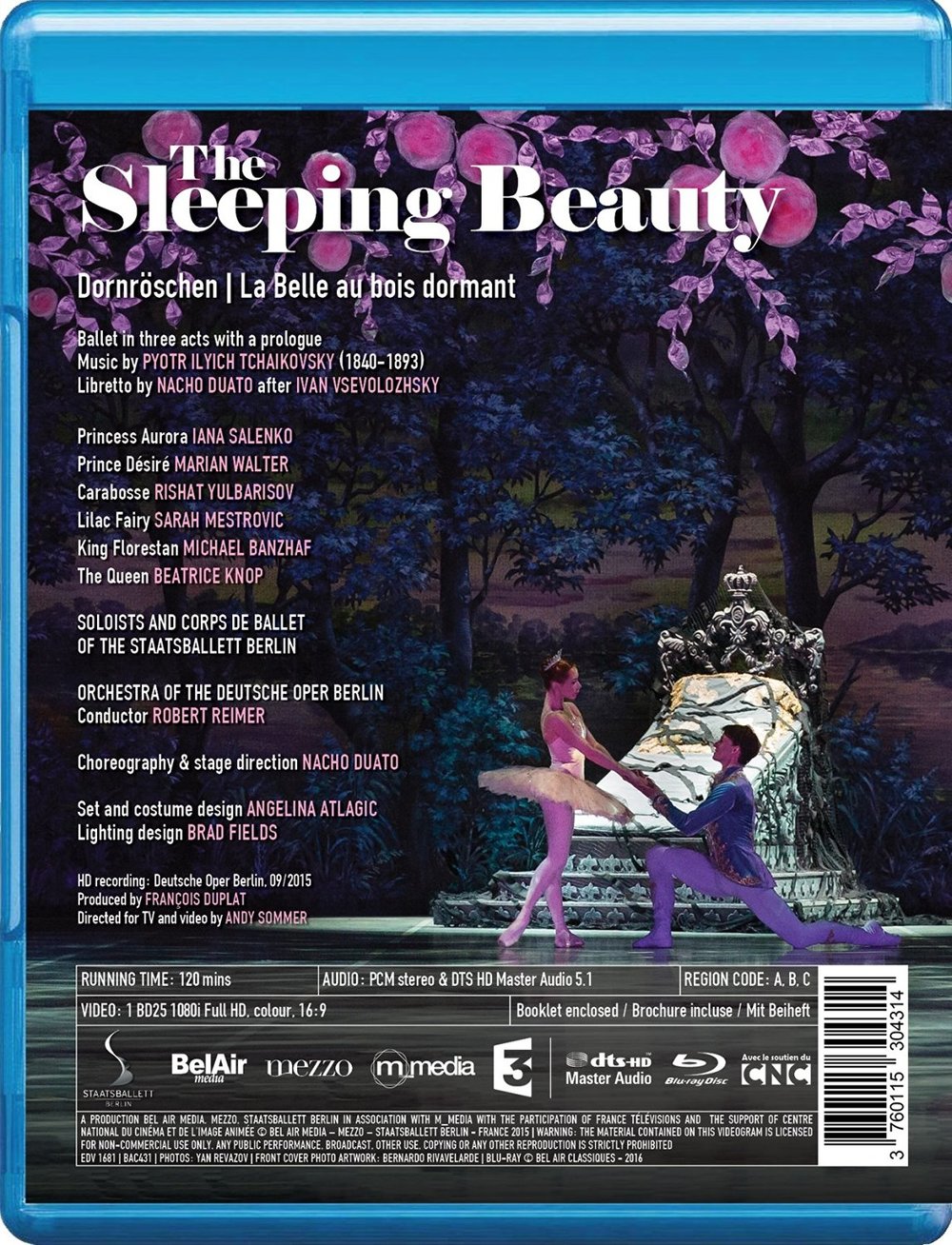

The Sleeping Beauty ballet. Music by Tchaikovsky. Libretto by Nacho Duato after Ivan Vsevolozhsky. Choreography and stage direction by Nacho Duato.
All dancers are soloists or members of the Corp de Ballet of the Staatsballett Berlin. Members of the Court are Iana Salenko (Aurora), Marian Walter (Prince Désiré), Michael Banzhaf (King Florestan), Beatrice Knop (Queen), Arshak Ghalumyan (Catalabutte, Master of Ceremony), Martina Böckmann (the Nurse), Elvis Abazi (Page), and Ty Gurfein (Page). Fairies and their suites are Anastasia Kurkova and Dominic Hodal (Candide Fairy), Krasina Pavlova and Alexej Orlenco (Fleur de Farine Fairy), Aurora Dickie and Kévin Pouzou (Miettes Fairy), Marina Kanno and Federico Spallitta (Canari Fairy), Elena Pris and Olaf Kollmannsperger (Violante Fairy), Sarah Mestrovic and Nikolay Korypaev (Lilac Fairy), Rishat Yulbarisov and Alexander Abdukarimov, Alexander Korn, Artur Lill, Vladislav Marinov, Lucio Vidal, and Wei Wang (Carabosse). The four Princes are Nikolay Korypaev, Kévin Pouzou, Alexej Orlenco, and Olaf Kollmannsperger. Sebnem Gülseker is the Duchess. The trio consists of Krasina Pavlova, Vladislav Marinov, and Ulian Topor. The Fairy Jems are Anastasia Kurkova (Sapphire), Krasina Pavlova (Amethyst), Elena Pris (Gold) and Olaf Kollmannsperger (Gold). Danielle Muir and Ulian Topor are Puss in Boots and the White Pussycat. The Bluebird and Princess Florine are Marina Kanno and Nikolay Korypaev. Little Red Riding Hood and the Wolf are Maria Boumpouli and Dominic Hodal. The Frog Prince and the Princess are Lisa Breuker and Alexander Shpak. Cinderella and the Prince are Aoi Suyama and Giacomo Bevilacqua. The Beauty and the Beast are Xenia Wiest and Taras Bilenko.
Robert Reimer conducts the Orchestra of the Deutsche Oper Berlin. Set and costume designs by Angelina Atlagic; lighting by Brad Fields. Directed for TV and video by Andy Sommer. Produced by François Duplat. Released 2016, disc has 5.1 dts-HD Master Audio sound. Grade: A+
The Staatsballett Berlin (Berlin State Ballet) went through a long reorganization at the same time the Berlin State Opera building was being renovated. Nacho Duato became Artistic Director in 2014. Subject title is our first HDVD from Duato, and it's a triumphal combination of classical material in a slick, clean, modern style. The question immediately arises: how does this show compare to the magnificent Sleeping Beauty published by the Bolshoi Ballet in 2012? The Bolshoi has 230 dancers; the Berlin folks have about 80. Can Berlin be competitive? The answer is “yes;” but before we explain why, let's see screenshots. Next below is the opening of Duato's Prologue. This is the best image we could get working from the Blu-ray recording:
Now let's see this scene as presented by the Berlin PR folks in a shot from a still camera. The first thing we note is a remarkably beautiful set from Angelina Atlagic, who also did the costumes. The images we get in our HT are much closer to the view below than to that above. The Berlin cast here numbers about 27; the Bolshoi puts maybe as many as 40 people on stage. At times the Berlin stage does look a bit empty, but Duato covers this up with an energetic dancing style accented with unusual swooping moves. It's classical in nature, but modern in presentation and seems to fill up the stage for the viewer:
Here’s an aside: if you think the design style for the staging above is vaguely familiar, you might have in mind the image next below of Daybreak by painter and illustrator Maxfield Parrish, said to be the most popular art print of the 20th century (in the USA at least). Note the odd hues and clean, updated neo-classicism in the famous painting and in Duato’s designs:
Duato's evil fairy, Carabosse (Rishat Yulbarisov) is competitive with anybody:
And once you get into the story, dancing and acting agility are more important than the number of people on the stage. Next below is Sarah Mestrovic as the Lilac Fairy, who does a good job of assuring us that baby Aurora will not die but merely go to sleep (for 100 years):
All the other fairies line up behind Lilac; now we see how beautiful the Angelina Atlagic costumes are. Everything here is, it appears, completely new and sparkling clean:
Act 1. Now Aurora (Iana Salenko) is 16 and it's time to find her a Prince. The King (Michael Banzhaf) and the rest of the family have pretty much forgotten about Carabosse:
Aurora's friends:
It's impossible to get a shot from a video like the next view below. Even with a $5,000 single shot camera, you still see some minor motion blur in this PR photo:
Aurora is such a good, modest, and shy girl at 16. The Queen explains to her that she has to dance with the 4 boys who are visiting:
All is going well until that promised pin-prick:
The Lilac Fairy has been standing by ready for action:
And all the other Fairies are united in solidarity—a completely unexpected and modern touch which seems appropriate to me:
Below is the PR version of the view above, which I include as further evidence of the amazingly beautiful costumes designed by Angelina Atlagic:
Act 2. We ran a Wonk Worksheet on this video. Andy Sommer does a fantastic job of shooting about 90% of his clips as whole stage or part-stage-whole-body shots. However, in the Prologue and Act 1 his pace (number of seconds in the average clip) is too fast at only 8 seconds per clip. In Act 2, Sommer is able to slow down his pace to a more stately 10+ seconds per clip. Now we see the Prince (Marian Walter) who is on a hunting party with friends and a visiting Princess:
100 years have passed since Aurora went to sleep, so Angelina Atlagic comes up with a new look and color scheme:
The Prince is bored with the hunt. Something tells him to wander off by himself. Note we have a completely new set. The Prince encounters the Lilac Fairy and mysterious girls:
The Lilac Fairy invokes a mirage of the Sleeping Beauty:
The Mirage dances with the Prince, but she's still asleep. All this looks rather grim in these screenshots. It's looks great, however, in the HT:
Now the Prince goes all in. He hitchhikes a ride with a stranger:
In German, the Sleeping Beauty is "Dornröschen" (Rosebud with a Thorn). So here the Prince finds what he seeks in a magnificent arbor of roses:
And Aurora is still as shy and chaste as ever:
Act 3, the Wedding. In this Act, Sommer keeps his video at 90% whole-body and improves his pace to 13 seconds per average clip. Once again the images in the HT look much brighter than these screenshots:
We think this is the "Trio" and a character named "Gold":
The White Pussycat and Puss-in-Boots:
Bluebird and Princess Florine next below (this is a screenshot—not a PR photo):
Three shots from the wedding pas de deux:
Scenes from the wedding (the Bolshoi Ballet version has an Apotheosis rather than a wedding):
By now we have proved to you what a beautiful show this is. Next we suggest you look at our screenshots of the Bolshoi Ballet Sleeping Beauty. The Bolshoi version runs 138 minutes vs. 120 minutes for the Duato show. For opulence, magnificence, thoroughness, attention to historical detail, and an endless display of star-level dancers, the Bolshoi version isn't likely to be challenged for a long time. Nobody else can afford to even try. Also, Vincent Bataillon in Moscow made one of the most impressive dance videos ever with his 80% full-body production and a magisterially slow pace of about 22 seconds for the average video clip. So for seasoned ballet lovers who want it all, the Bolshoi battleship is the way to go.
But for many, maybe most, modern audiences, the Moscow juggernaut may be too much—too heavy, traditional, sweet, and long. Modern viewers may prefer something shorter, cleaner, and "smarter" ending in a gorgeous, romantic, dreamy wedding rather than an apotheosis. That's why we argue that 60-year-old Duato has managed to be competitive with 90-year-old Grigorovich even if Duato has only 1/3 of the resources as the wizard in Moscow. (We'll also mention here that the Berlin Staatsballett has a beautiful and impressive website with a lot of background and educational material for fledgling ballet fans to enjoy.) So we give Duato an A+ (even with the weakness in video content discussed above).
Below are several good clips, each in German and English. (There are other clips we avoid as they show Leonid Sarafanov dancing the Prince rather than Marian Walter.)
OR



































